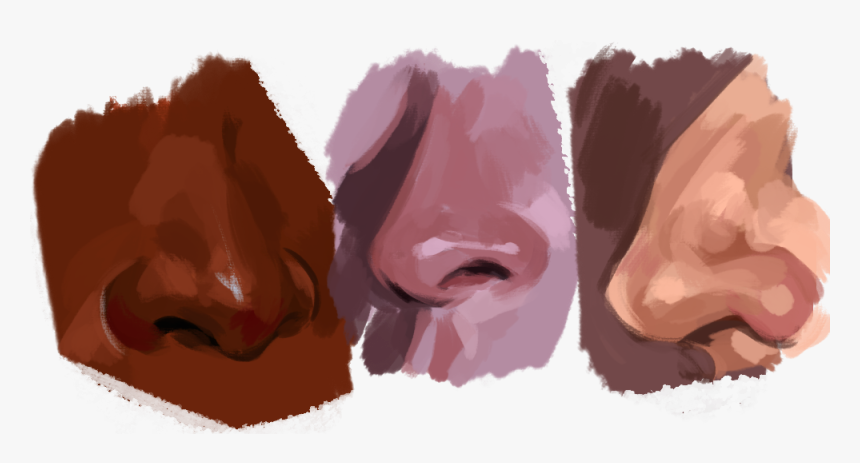Painting Of A Nose - Nose painting is an art form that requires patience, attention to detail, and a steady hand. A nose can be one of the most challenging parts of a portrait to paint - but with the right techniques, anyone can create a lifelike, realistic nose that adds depth and dimension to their work. In this post, we'll explore some tips, ideas, and how-tos for painting a nose in oil, from choosing the right colors to building up the layers and texture of the paint.
Follow me @ronaldrestituyo! For more! Nose oil painting process
Tip 1: Choose the right colors
When painting a nose in oil, choosing the right colors is key to creating a realistic and lifelike effect. The nose is a complex structure made up of many different colors and shades - from the warm pinks and peaches of the flesh to the cool blues and purples of the shadows beneath the nostrils. To create a sense of depth and dimension, it's important to use a variety of colors and hues to build up the layers of the paint.

Tip 2: Build up the layers of the paint
When painting a nose in oil, it's important to build up the layers of the paint gradually - starting with the lightest colors and gradually adding in darker shades and shadows. This will help create a sense of depth and dimension, and will allow you to blend the colors together seamlessly for a natural and lifelike effect. Use a light touch and a very small brush to apply the paint, and blend the colors together carefully to avoid any harsh lines or edges.
How to Paint a Nose in Oil - Online Art Lessons
Idea 1: Study the anatomy of the nose
Before you start painting a nose in oil, take some time to study the anatomy of the nose in detail. Look at photographs or images of noses from different angles and perspectives, and pay close attention to the structure and shape of the nose as well as the colors and textures. This will help you to create a more natural and lifelike effect in your painting.

Idea 2: Use a limited color palette
One technique that can be effective when painting a nose in oil is to use a limited color palette. By limiting the number of colors you use, you can create a more harmonious and cohesive effect in your painting, and simplify the process of choosing and mixing colors. Choose a base color for the flesh tone of the nose, and then mix in shades and hues of that color for the shadows and highlights.
How to Paint and Draw Pencil Portraits the Harry Fredman Method
How-to 1: Start by sketching the outlines of the nose
Before you start painting a nose in oil, it can be helpful to sketch the outlines of the nose in pencil first. Use light, delicate strokes to create a basic outline of the nose, and refine the details gradually as you work. This will help you to create a more accurate and realistic painting, and give you a better understanding of the proportions and structure of the nose.
How-to 2: Use a small brush for details
When it comes to painting the details of the nose, it's important to use a small brush for precision and control. Choose a brush with fine hairs and a sharp point, and work carefully to create the subtle nuances of the nose - from the tiny hairs on the surface of the skin to the small creases and folds in the flesh. Take your time and work slowly and deliberately, and you'll be amazed at the level of detail you can achieve.
Art Tutorials | Art Reference
Idea 1: Study the light and shadows of the nose
One of the most important elements of painting a nose in oil is capturing the light and shadows of the nose. Study the shadows beneath the nostrils, the highlights on the bridge of the nose, and the subtle gradations of light and dark along the sides of the nose. Use a light touch and a small brush to build up the layers of paint gradually, working in thin layers and blending the colors together carefully.

Idea 2: Experiment with different shapes and sizes
No two noses are the same - and when it comes to painting a nose in oil, there's plenty of room for experimentation and creativity. Play around with different shapes and sizes, and experiment with different angles and perspectives to find the approach that works best for you. Whether you're painting a realistic portrait or a more stylized interpretation, there's no limit to the possibilities when it comes to painting a nose in oil.
Oil Painting Nose Tutorial, HD Png Download - kindpng
How-to: Use a glazing technique for a smooth finish
If you're looking for a smooth, seamless finish for your nose painting in oil, try using a glazing technique. This involves layering thin, transparent washes of paint over the surface of the nose, gradually building up the texture and color in a subtle and controlled way. Use a small brush and work carefully to avoid streaks or uneven areas, and experiment with different colors and blends to create a truly unique effect.

These are just a few tips, ideas, and how-tos for painting a nose in oil - with practice and patience, anyone can create a lifelike and realistic nose that adds depth and dimension to their artwork. Whether you're a beginner just starting out or an experienced artist looking to hone your skills, there's always something new to learn when it comes to nose painting in oil. So grab your brushes and get started - the possibilities are endless!
Find more articles about Painting Of A Nose